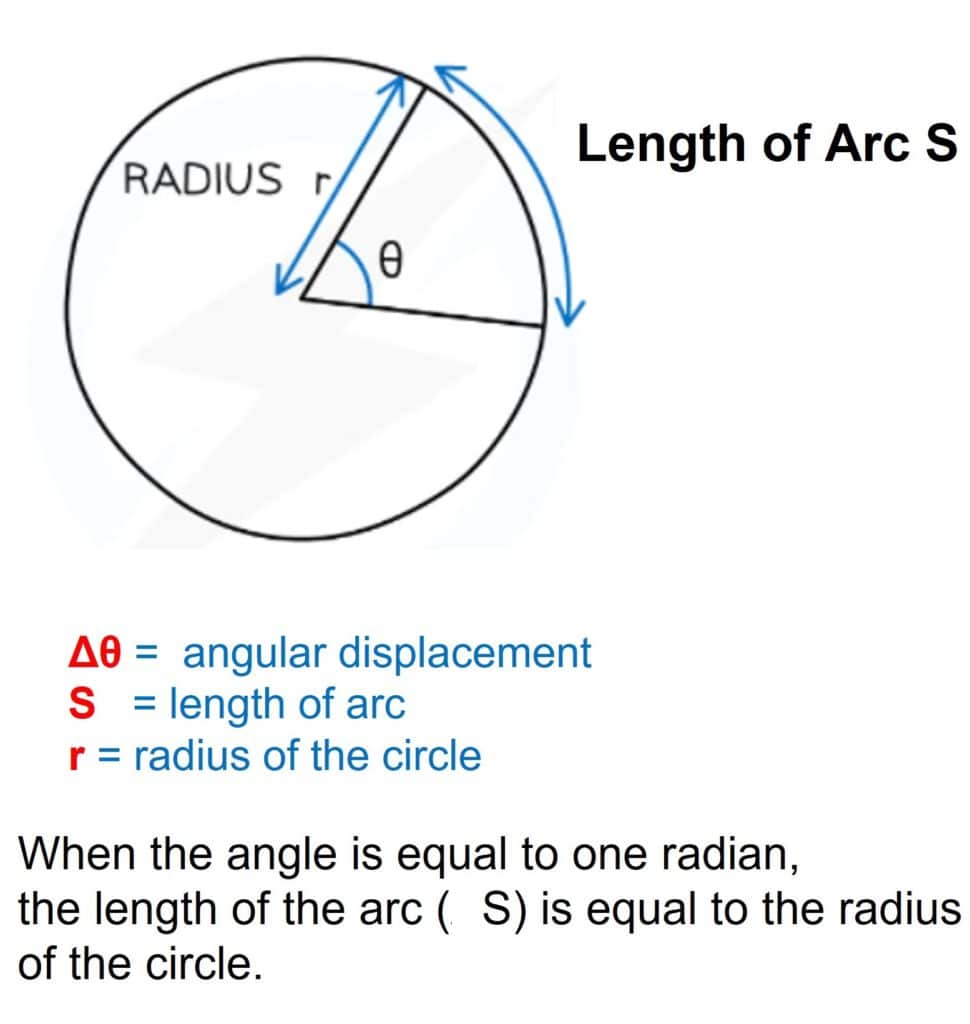Angular displacement is defined as the shortest angle between the initial and final positions of an object moving in a circular motion around a fixed point. It is a vector quantity, which means that angular displacement has a size and a direction associated with it.
In other words, angular displacement represents the angle formed between the final position and the initial position of a rotating line. This rotation of a rigid body over a fixed axis is known as rotational motion. As compared to linear motion, angular displacement has a direction associated with it.
Simple examples of angular motion include the rotation of a bicycle tire, a toy top, a laboratory centrifuge, and the earth’s orbit around the sun.

| Property | Angular displacement |
| Definition | the shortest angle between the initial and final positions of an object moving in a circular motion around a fixed point. |
| Unit | rad/s |
| Examples | The motion of a bicycle tire, a toy top, a laboratory centrifuge, and the earth’s orbit around the sun. |
| Formula | θ =s/r ( |
Table of Contents
What is Angular Displacement?
The angular displacement (θ) of a body in circular motion is defined as the change in angle ( θf−θi), in radians, of a body as it rotates around a circle. In mathematical terms, It is the ratio of distance travelled around a circle and the radius of the circle. A radian (rad) is defined as the angle subtended at the center of a circle by an arc equal in length to the radius of the circle.

Angular Displacement-Key Points
- Angular velocity is the rate of change of angular displacement.
- For an object rotating about an axis, every point on the object has the same angular velocity.
- The angular displacement is not a length (not measured in meters or feet), so an angular displacement is different than a linear displacement.
- Rotation in the clockwise direction is negative and rotation in the counterclockwise direction is positive.
What is the Angular momentum?
Angular momentum (L) is the product of angular velocity (ω) and rotational inertia (I). Rotational inertial is a property of matter that opposes rotation. It is a measure of the distribution of mass (m) relative to its center of rotation (r). Its formula is I=mr2. Whereas angular velocity is the rate at which an object rotates or revolves about an axis or the rate at which the angular displacement between two bodies changes.
Angular momentum of a system is conserved when there are no external torques acting on the system.
Uniform Circular Motion
Uniform circular motion is described as the constant-speed movement of an item in a circle. An object in uniform circular motion moves at a constant pace. Despite this, it is speeding as a result of its shift of course. The acceleration is heading inwards. For example, each point on a propeller spinning at a consistent pace is executing a uniform circular motion. A watch’s second, minute, and hour hands are other examples.
Examples of Uniform Circular Motion
- The motion of artificial satellites around the earth
- The motion of the blades of the windmills
- Planets Revolving Around the Sun
- The motion of the hands of a clock
- The motion of the moon revolving around the earth
- The circular motion of the Ferris Wheel
Linear Motion
Linear motion (also known as rectilinear motion) is a one-dimensional motion along a straight line that can be represented mathematically with only one spatial dimension. Linear motion is defined as movement along a straight path, whereas nonlinear motion is any movement that is not in a straight line.
Linear Acceleration
Linear acceleration occurs when the velocity of an object traveling in a straight line rises or decreases over time. Acceleration can be positive or negative depending on whether the velocity is increasing or decreasing. In layman’s terms, linear acceleration is the rate of change in velocity without a change in direction.
Summary
This article explains the concept of angular displacement along with simple examples.
Angular displacement defines the movement of a segment as representing the change in angular position. It is measured in units of radians. Two pi radians equals 360 degrees.
Related Links
Can Displacement be Negative?
Can Work Be Negative?| Easy Explanation
How to Find Instantaneous Velocity
Can Velocity be Negative?
The Spring Constant & Spring Force Concept
Frequently Asked Questions
1. What is a polygon and Is a circle a polygon?
A polygon is not the same as a circle. From end to end, a polygon is a closed-form on a plane made up of a finite number of linked line segments. Because a circle is curved, it cannot be made from line segments and so does not meet the conditions for becoming a polygon. Check the full article “Is the circle a polygon?”.
2. Why do we use angular displacement?
Angular displacement aids in determining the position of an object in a circular motion. When an object moves around the circumference of a circle, it creates an angle at the circle’s center that starts at the object’s initial position and ends at the object’s final position.
3. Flexural strength?
A material’s flexural strength is the highest bending force that can be applied to it before it yields. A transverse bending test employing a three-point flexural test methodology is the most popular method of assessing a material’s flexural strength. Bending strength, modulus of rupture, and transverse rupture strength are all names for flexural strength.
4. Can displacement be negative?
Yes, because displacement is a vector quantity that depends on magnitude and direction, it can be negative. The negative symbol just denotes the direction. Please refer to the full article “Can displacement be negative?”.
5. Can force be negative?
Force can be negative since it is a vector variable that depends on magnitude and direction. The negative symbol just indicates the direction. Please refer to the full article “Can force be negative?”.
6. Momentum equation?
The momentum equation is simply the product of a moving object’s mass (m) and velocity (v).
When a thing moves and has mass, it has momentum.
7. What is Strain energy?
Strain energy is a type of potential energy stored in an item as a result of elastic deformation. When an item is deformed from its unstressed state, the external work done on it is turned into (and is considered equivalent to) the strain energy contained in it. It is measured in N-m or Joules.
8. Damped oscillation definition?
A damped oscillation is one that fades away over time. Examples include a swinging pendulum, a weight on a spring, and a resistor-inductor-capacitor (RLC) circuit.
9. What is centripetal acceleration?
Centripetal acceleration is the acceleration felt by a moving body traveling in a circular route. It is pointing towards the circle’s center.
10. Gravitational potential energy?
The energy that an object has as a result of its location in a gravitational field is referred to as gravitational potential energy (w). If the object is pushed straight up at a constant speed, the force (F) necessary to hoist it to the height (h) is equal to the object’s weight (mg).
For a moving body traversing a circular path, the acceleration produced by a centripetal force is called centripetal acceleration and is denoted by “ac“. It is directly proportional to the square of the velocity of the body and inversely proportional to the radius of the circle. The direction of this acceleration is radially towards the center of the circle.
It is the rate of displacement of a moving object. In other words, it is the speed at which an object moves in one direction. Its scalar magnitude is the speed of motion.
More Links
- BCl3 Lewis Structure in four simple steps - November 1, 2023
- PH3 Lewis Structure in four simple steps - October 8, 2023
- PF3 Lewis structure in four simple steps - September 24, 2023



